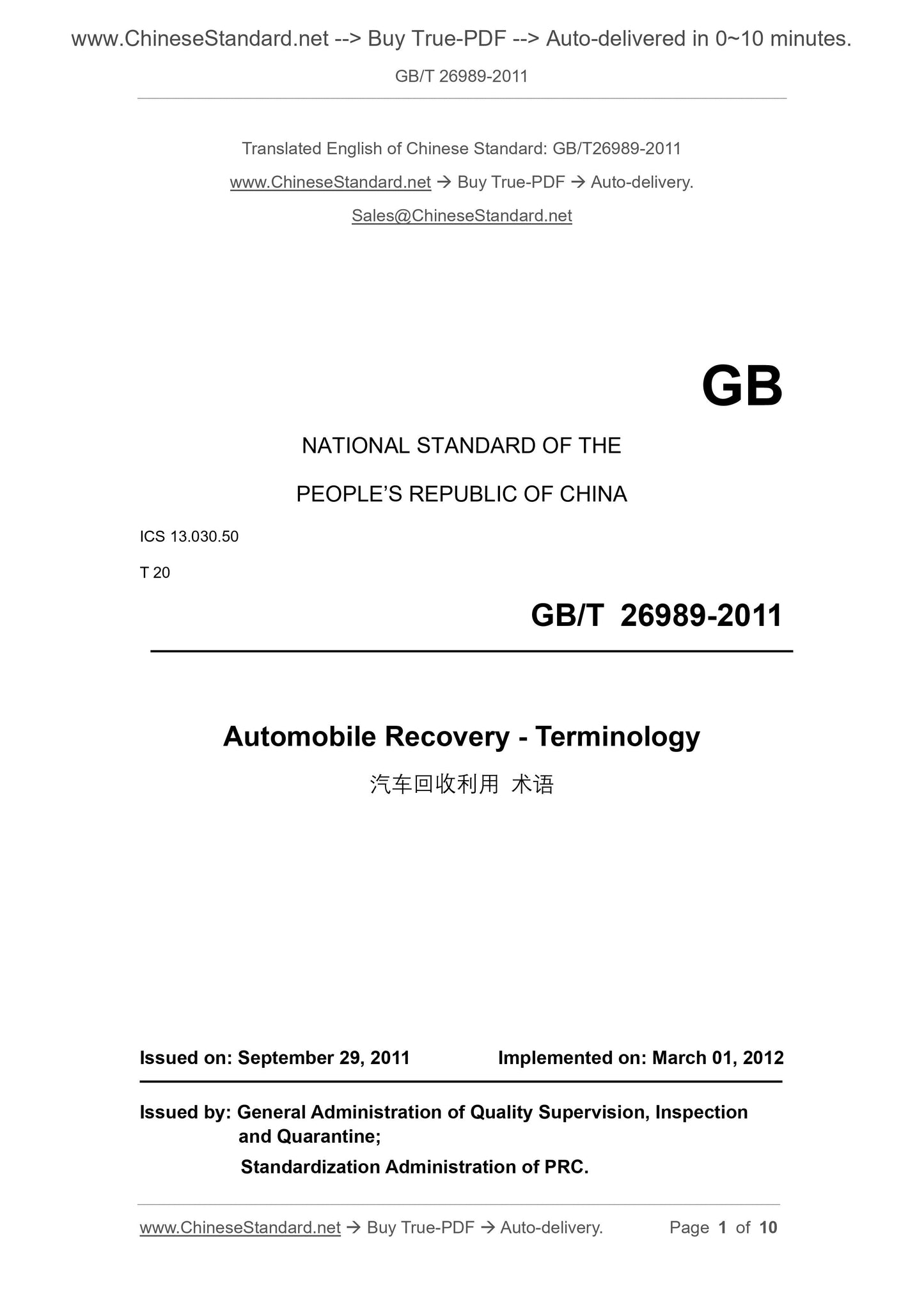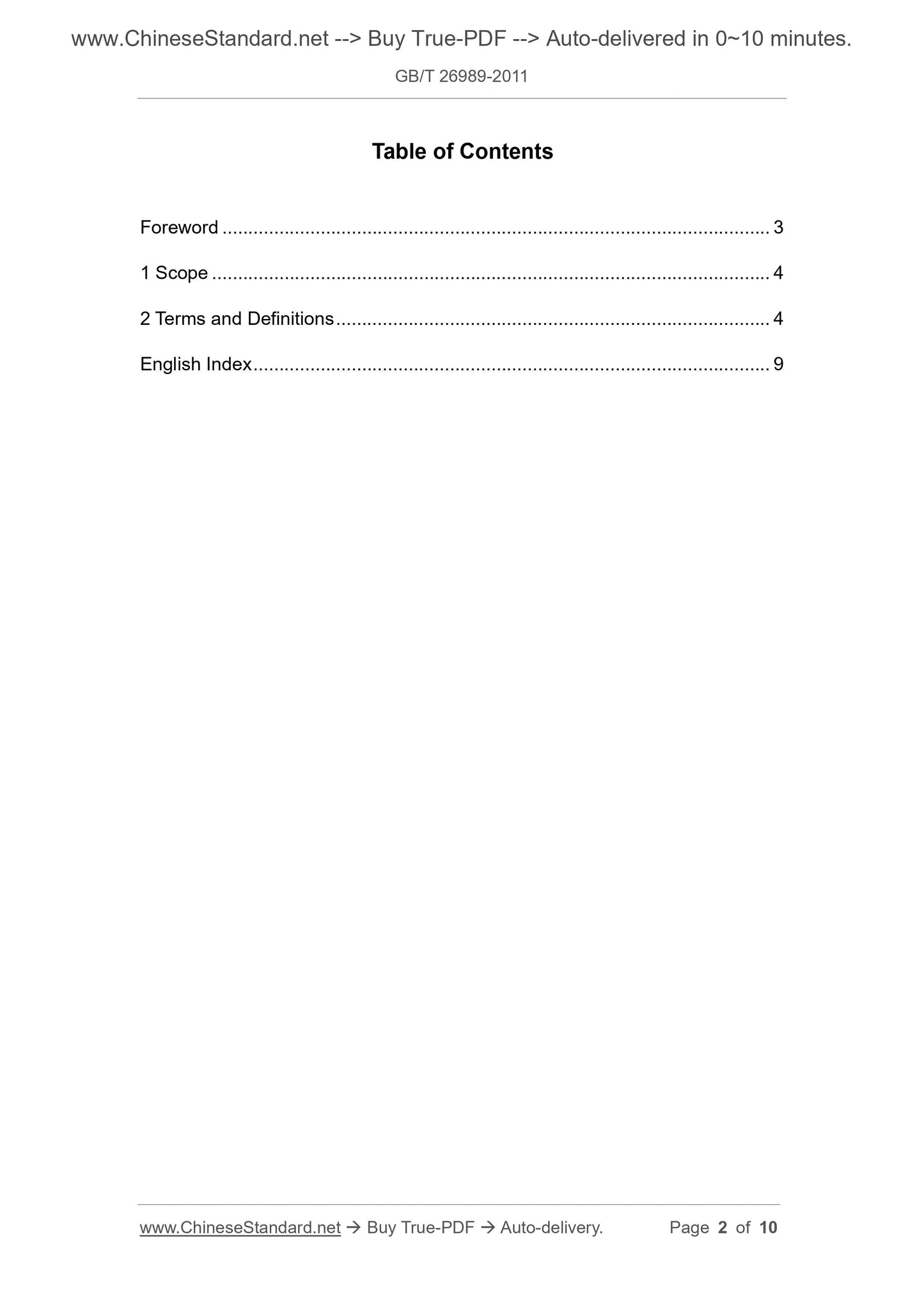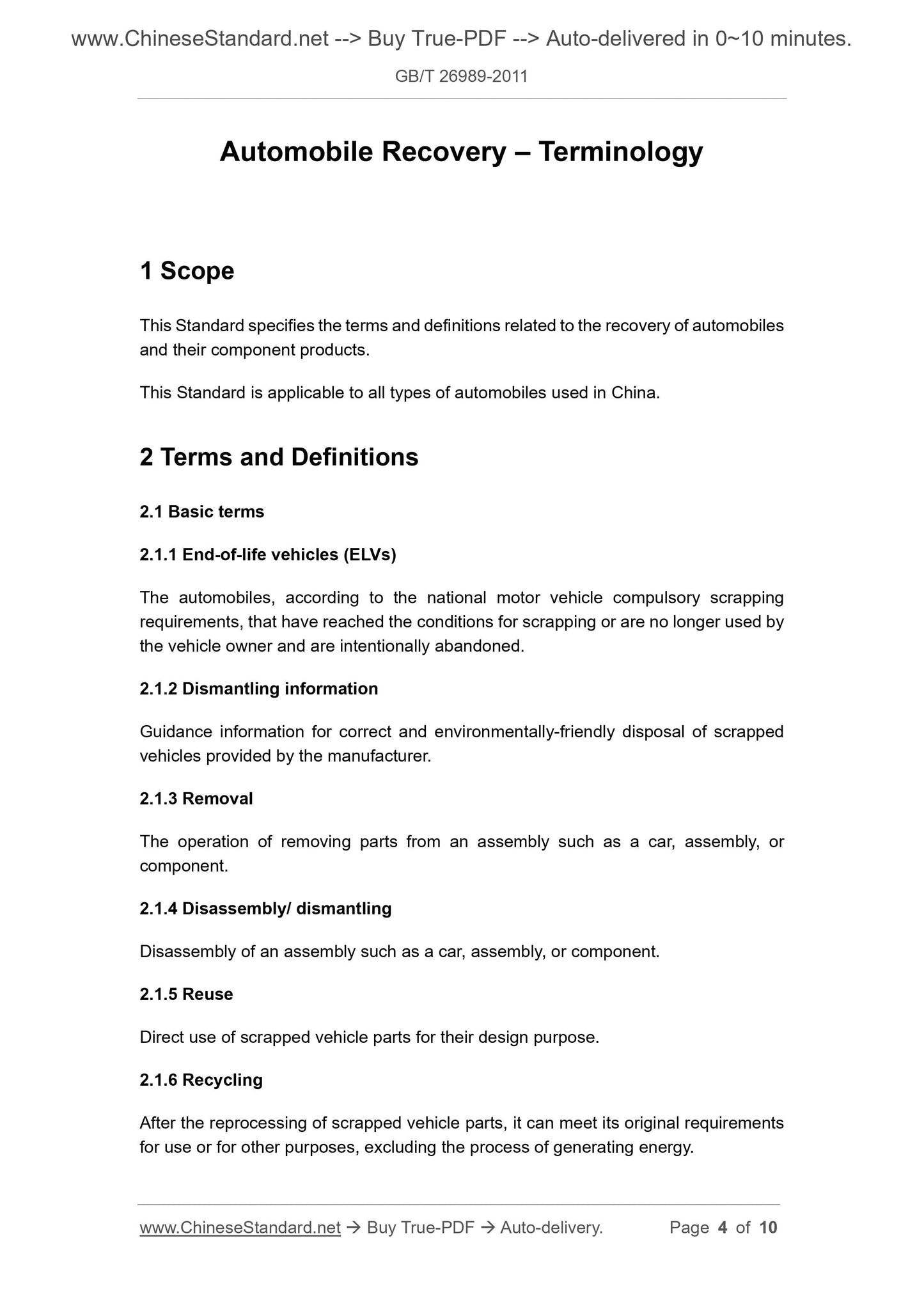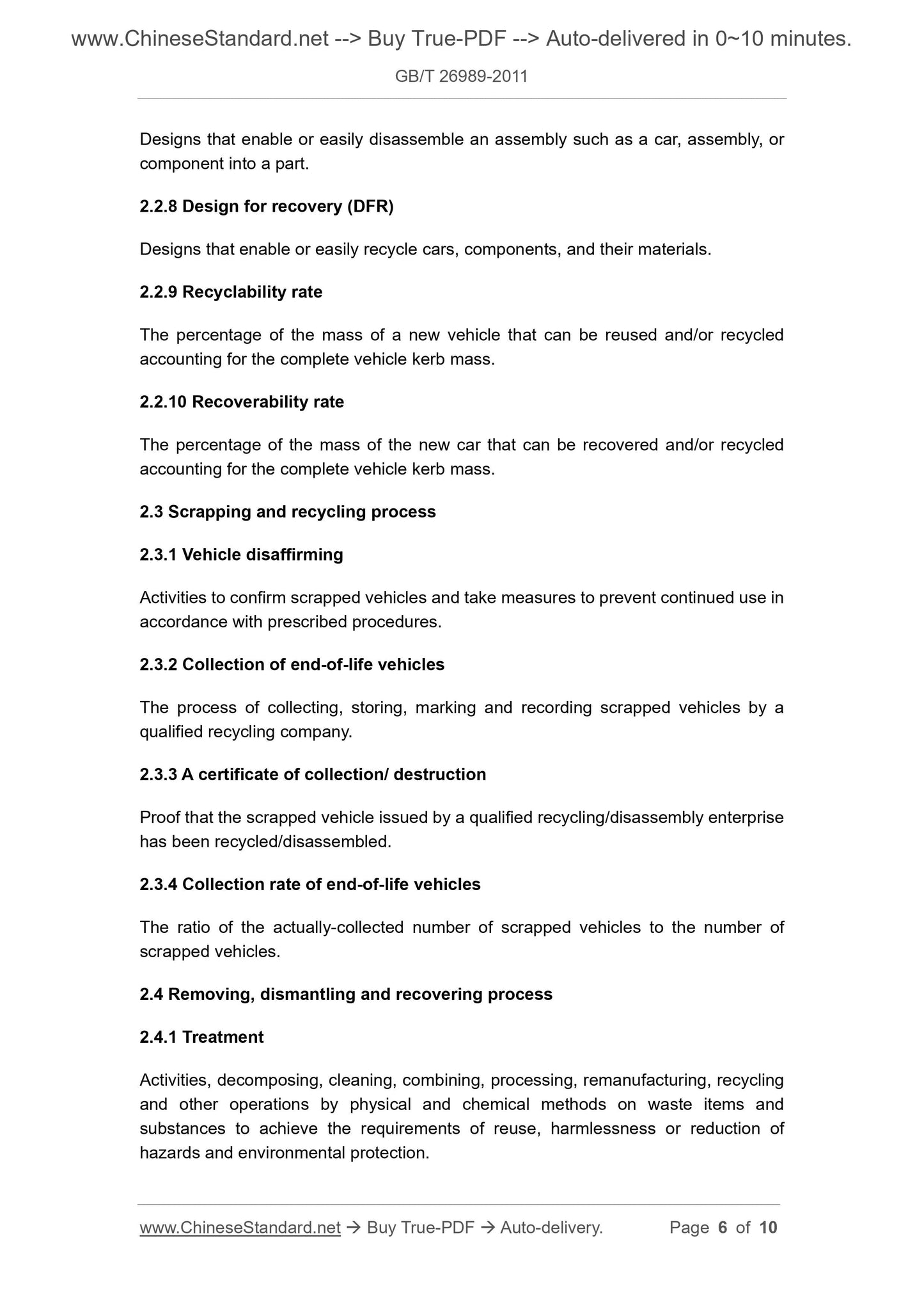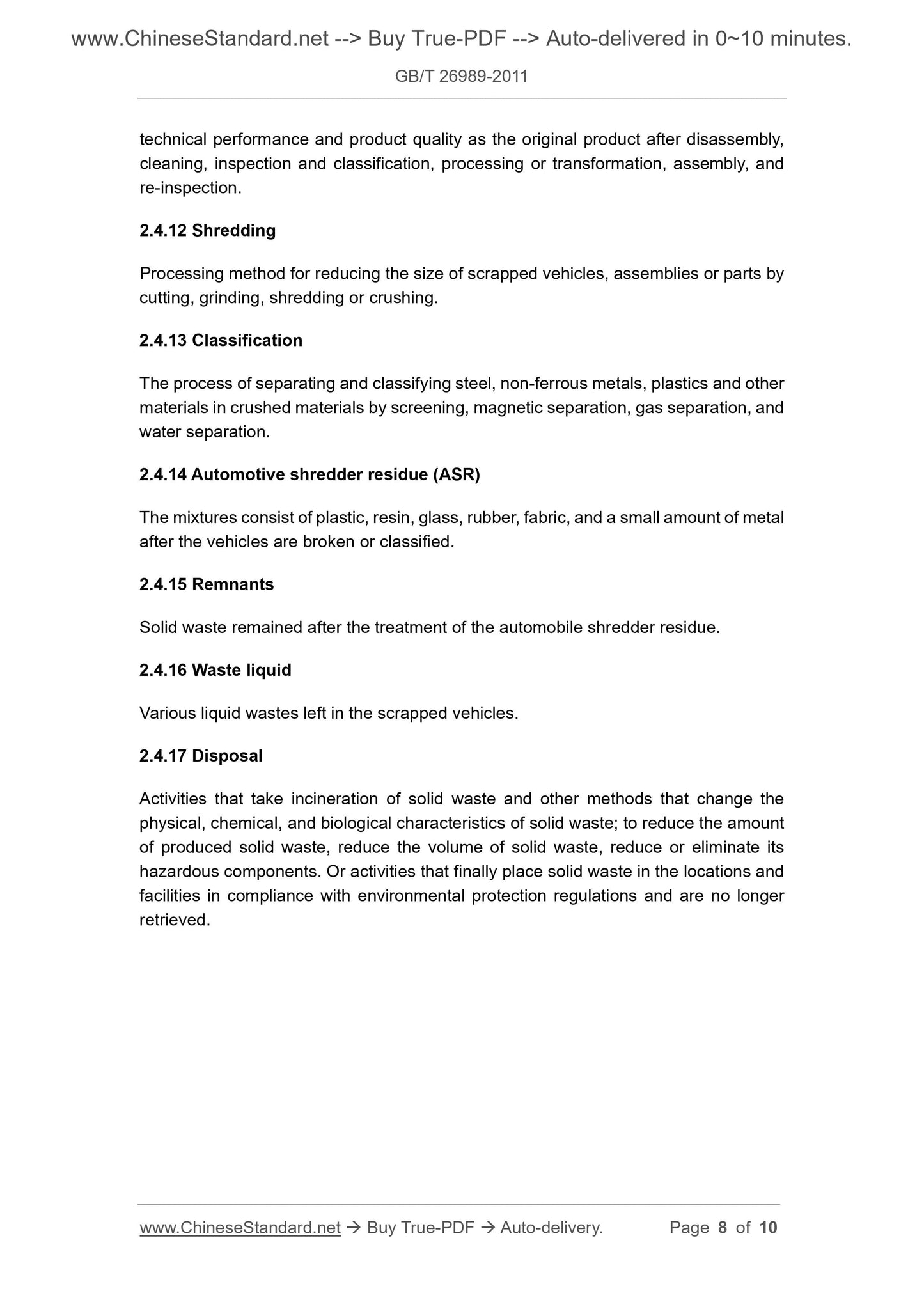1
/
of
5
PayPal, credit cards. Download editable-PDF and invoice in 1 second!
GB/T 26989-2011 English PDF (GBT26989-2011)
GB/T 26989-2011 English PDF (GBT26989-2011)
Regular price
$70.00 USD
Regular price
Sale price
$70.00 USD
Unit price
/
per
Shipping calculated at checkout.
Couldn't load pickup availability
Delivery: 3 seconds. Download true-PDF + Invoice.
Get QUOTATION in 1-minute: Click GB/T 26989-2011
Historical versions: GB/T 26989-2011
Preview True-PDF (Reload/Scroll if blank)
GB/T 26989-2011: Automobile recovery -- Terminology
GB/T 26989-2011
NATIONAL STANDARD OF THE
PEOPLE’S REPUBLIC OF CHINA
ICS 13.030.50
T 20
Automobile Recovery - Terminology
ISSUED ON: SEPTEMBER 29, 2011
IMPLEMENTED ON: MARCH 01, 2012
Issued by: General Administration of Quality Supervision, Inspection
and Quarantine;
Standardization Administration of PRC.
Table of Contents
Foreword ... 3
1 Scope ... 4
2 Terms and Definitions ... 4
English Index ... 9
Automobile Recovery – Terminology
1 Scope
This Standard specifies the terms and definitions related to the recovery of automobiles
and their component products.
This Standard is applicable to all types of automobiles used in China.
2 Terms and Definitions
2.1 Basic terms
2.1.1 End-of-life vehicles (ELVs)
The automobiles, according to the national motor vehicle compulsory scrapping
requirements, that have reached the conditions for scrapping or are no longer used by
the vehicle owner and are intentionally abandoned.
2.1.2 Dismantling information
Guidance information for correct and environmentally-friendly disposal of scrapped
vehicles provided by the manufacturer.
2.1.3 Removal
The operation of removing parts from an assembly such as a car, assembly, or
component.
2.1.4 Disassembly/ dismantling
Disassembly of an assembly such as a car, assembly, or component.
2.1.5 Reuse
Direct use of scrapped vehicle parts for their design purpose.
2.1.6 Recycling
After the reprocessing of scrapped vehicle parts, it can meet its original requirements
for use or for other purposes, excluding the process of generating energy.
Designs that enable or easily disassemble an assembly such as a car, assembly, or
component into a part.
2.2.8 Design for recovery (DFR)
Designs that enable or easily recycle cars, components, and their materials.
2.2.9 Recyclability rate
The percentage of the mass of a new vehicle that can be reused and/or recycled
accounting for the complete vehicle kerb mass.
2.2.10 Recoverability rate
The percentage of the mass of the new car that can be recovered and/or recycled
accounting for the complete vehicle kerb mass.
2.3 Scrapping and recycling process
2.3.1 Vehicle disaffirming
Activities to confirm scrapped vehicles and take measures to prevent continued use in
accordance with prescribed procedures.
2.3.2 Collection of end-of-life vehicles
The process of collecting, storing, marking and recording scrapped vehicles by a
qualified recycling company.
2.3.3 A certificate of collection/ destruction
Proof that the scrapped vehicle issued by a qualified recycling/disassembly enterprise
has been recycled/disassembled.
2.3.4 Collection rate of end-of-life vehicles
The ratio of the actually-collected number of scrapped vehicles to the number of
scrapped vehicles.
2.4 Removing, dismantling and recovering process
2.4.1 Treatment
Activities, decomposing, cleaning, combining, processing, remanufacturing, recycling
and other operations by physical and chemical methods on waste items and
substances to achieve the requirements of reuse, harmlessness or reduction of
hazards and environmental protection.
technical performance and product quality as the original product after disassembly,
cleaning, inspection and classification, processing or transformation, assembly, and
re-inspection.
2.4.12 Shredding
Processing method for reducing the size of scrapped vehicles, assemblies or parts by
cutting, grinding, shredding or crushing.
2.4.13 Classification
The process of separating and classifying steel, non-ferrous metals, plastics and other
materials in crushed materials by screening, magnetic separation, gas separation, and
water separation.
2.4.14 Automotive shredder residue (ASR)
The mixtures consist of plastic, resin, glass, rubber, fabric, and a small amount of metal
after the vehicles are broken or classified.
2.4.15 Remnants
Solid waste remained after the treatment of the automobile shredder residue.
2.4.16 Waste liquid
Various liquid wastes left in the scrapped vehicles.
2.4.17 Disposal
Activities that take incineration of solid waste and other methods that change the
physical, chemical, and biological characteristics of solid waste; to reduce the amount
of produced solid waste, reduce the volume of solid waste, reduce or eliminate its
hazardous components. Or activities that finally place solid waste in the locations and
facilities in compliance with environmental protection regulations and are no longer
retrieved.
Get QUOTATION in 1-minute: Click GB/T 26989-2011
Historical versions: GB/T 26989-2011
Preview True-PDF (Reload/Scroll if blank)
GB/T 26989-2011: Automobile recovery -- Terminology
GB/T 26989-2011
NATIONAL STANDARD OF THE
PEOPLE’S REPUBLIC OF CHINA
ICS 13.030.50
T 20
Automobile Recovery - Terminology
ISSUED ON: SEPTEMBER 29, 2011
IMPLEMENTED ON: MARCH 01, 2012
Issued by: General Administration of Quality Supervision, Inspection
and Quarantine;
Standardization Administration of PRC.
Table of Contents
Foreword ... 3
1 Scope ... 4
2 Terms and Definitions ... 4
English Index ... 9
Automobile Recovery – Terminology
1 Scope
This Standard specifies the terms and definitions related to the recovery of automobiles
and their component products.
This Standard is applicable to all types of automobiles used in China.
2 Terms and Definitions
2.1 Basic terms
2.1.1 End-of-life vehicles (ELVs)
The automobiles, according to the national motor vehicle compulsory scrapping
requirements, that have reached the conditions for scrapping or are no longer used by
the vehicle owner and are intentionally abandoned.
2.1.2 Dismantling information
Guidance information for correct and environmentally-friendly disposal of scrapped
vehicles provided by the manufacturer.
2.1.3 Removal
The operation of removing parts from an assembly such as a car, assembly, or
component.
2.1.4 Disassembly/ dismantling
Disassembly of an assembly such as a car, assembly, or component.
2.1.5 Reuse
Direct use of scrapped vehicle parts for their design purpose.
2.1.6 Recycling
After the reprocessing of scrapped vehicle parts, it can meet its original requirements
for use or for other purposes, excluding the process of generating energy.
Designs that enable or easily disassemble an assembly such as a car, assembly, or
component into a part.
2.2.8 Design for recovery (DFR)
Designs that enable or easily recycle cars, components, and their materials.
2.2.9 Recyclability rate
The percentage of the mass of a new vehicle that can be reused and/or recycled
accounting for the complete vehicle kerb mass.
2.2.10 Recoverability rate
The percentage of the mass of the new car that can be recovered and/or recycled
accounting for the complete vehicle kerb mass.
2.3 Scrapping and recycling process
2.3.1 Vehicle disaffirming
Activities to confirm scrapped vehicles and take measures to prevent continued use in
accordance with prescribed procedures.
2.3.2 Collection of end-of-life vehicles
The process of collecting, storing, marking and recording scrapped vehicles by a
qualified recycling company.
2.3.3 A certificate of collection/ destruction
Proof that the scrapped vehicle issued by a qualified recycling/disassembly enterprise
has been recycled/disassembled.
2.3.4 Collection rate of end-of-life vehicles
The ratio of the actually-collected number of scrapped vehicles to the number of
scrapped vehicles.
2.4 Removing, dismantling and recovering process
2.4.1 Treatment
Activities, decomposing, cleaning, combining, processing, remanufacturing, recycling
and other operations by physical and chemical methods on waste items and
substances to achieve the requirements of reuse, harmlessness or reduction of
hazards and environmental protection.
technical performance and product quality as the original product after disassembly,
cleaning, inspection and classification, processing or transformation, assembly, and
re-inspection.
2.4.12 Shredding
Processing method for reducing the size of scrapped vehicles, assemblies or parts by
cutting, grinding, shredding or crushing.
2.4.13 Classification
The process of separating and classifying steel, non-ferrous metals, plastics and other
materials in crushed materials by screening, magnetic separation, gas separation, and
water separation.
2.4.14 Automotive shredder residue (ASR)
The mixtures consist of plastic, resin, glass, rubber, fabric, and a small amount of metal
after the vehicles are broken or classified.
2.4.15 Remnants
Solid waste remained after the treatment of the automobile shredder residue.
2.4.16 Waste liquid
Various liquid wastes left in the scrapped vehicles.
2.4.17 Disposal
Activities that take incineration of solid waste and other methods that change the
physical, chemical, and biological characteristics of solid waste; to reduce the amount
of produced solid waste, reduce the volume of solid waste, reduce or eliminate its
hazardous components. Or activities that finally place solid waste in the locations and
facilities in compliance with environmental protection regulations and are no longer
retrieved.
Share
